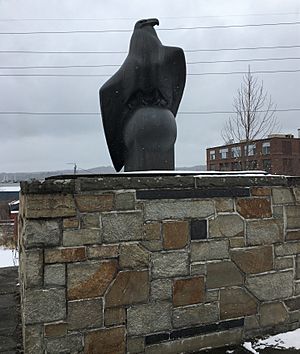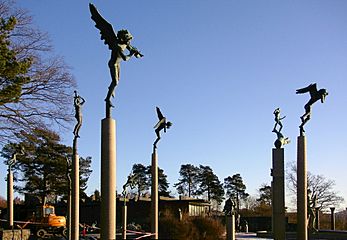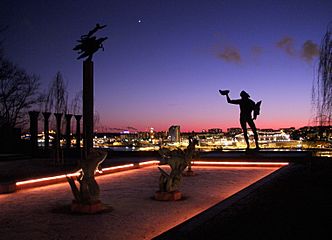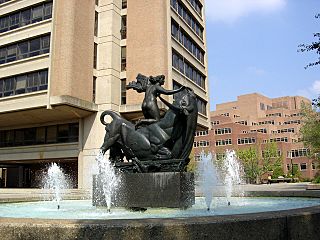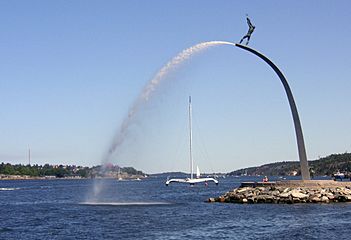Carl Milles facts for kids
Quick facts for kids
Carl Milles
|
|
|---|---|

Carl Milles by his desk in the Millesgården in Sweden 1955
|
|
| Born | 23 June 1875 Lagga |
| Died | 19 September 1955 Lidingö församling |
| Occupation | Sculptor, architect |
| Spouse(s) | Olga Milles |
| Parent(s) | |
| Family | Ruth Milles, Tage Millés, Evert Milles, Stig Milles |
| Website | https://www.millesgarden.se/home.aspx |
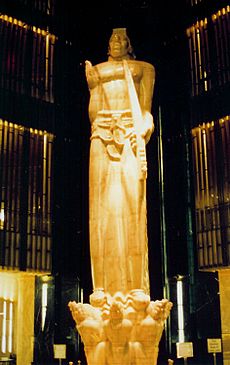
Carl Milles (born Carl Wilhelm Emil Andersson; 1875–1955) was a famous Swedish sculptor. He created many well-known statues and fountains. Carl was married to artist Olga Milles and was the brother of Ruth Milles. His half-brother was the architect Evert Milles.
Some of his most famous works include the Gustaf Vasa statue in Stockholm and the Poseidon statue in Gothenburg. He also made the Orpheus group outside the Stockholm Concert Hall. His home near Stockholm, called Millesgården, is now a museum. It is also where he is buried.
Contents
About Carl Milles
Carl Milles was born in 1875 near Uppsala, Sweden. In 1897, he traveled to Paris, France. He planned to go to Chile, but he stayed in Paris instead. There, he studied art and worked in the studio of the famous sculptor Auguste Rodin. Carl slowly became known for his own sculptures.
In 1904, Carl and his wife Olga moved to Munich, Germany. Two years later, they came back to Sweden. They bought land on an island near Stockholm called Lidingö. This is where they built Millesgården between 1906 and 1908. It was Carl's home and workshop. In 1936, Millesgården became a foundation and was given to the Swedish people. Today, it is a popular museum.
Carl Milles in America
In 1931, an American publisher named George Gough Booth invited Carl Milles to Michigan, USA. Carl became a sculptor at the Cranbrook Educational Community. As part of his work, he also created large sculptures for other places.
In 1938, Carl made a sculpture for the 300th anniversary of New Sweden. This was when Swedish colonists first came to America. The sculpture shows a copy of the Kalmar Nyckel, the ship that brought the colonists. You can see this sculpture at Fort Christina in Wilmington, Delaware.
Carl Milles is well known in America for his fountains. One famous fountain is The Meeting of the Waters in St. Louis, Missouri. It shows the Missouri and Mississippi Rivers joining together. When it was shown in 1940, some people found its playful figures a bit unusual.
Another important work is The Hand of God. This statue is outside the Frank Murphy Hall of Justice in Detroit, Michigan. It was made to honor Frank Murphy, who was a mayor, governor, and Supreme Court Justice. The statue is also used as a small copy for the Global Award for Entrepreneurship Research.
Carl and Olga Milles returned to Sweden in 1951. They spent their summers at Millesgården. In winters, they lived in Rome, Italy, where they had a studio. Carl Milles passed away in 1955. He and Olga are buried in a small stone chapel at Millesgården.
Famous Sculptures by Carl Milles
Carl Milles created many impressive sculptures. Here are some of his notable works:
- Aganippe Fountain, Metropolitan Museum of Art, New York City, 1951-1955
- Aviator Monument, Karlaplan, Stockholm, 1931
- Fountain of Faith, National Memorial Park cemetery, Falls Church, Virginia, 1939-1952
- Gustav Vasa Statue, Nordic Museum, Stockholm, 1905-1907 and 1925
- Folkung Fountain, Old Square, Linköping, 1924–1927
- Sten Sture Monument, Uppsala, 1902–1925
- Indian God of Peace, City Hall, Saint Paul, Minnesota, 1932–1936
- Bronze doors, Finance Building, Pennsylvania State Capitol Complex, Harrisburg, Pennsylvania, 1938
- Diana Fountain, Matchstick Palace, Stockholm, 1927–28
- Europe and the Bull Fountain, Stora Torg, Halmstad, 1924–1926
- Exterior sculpted decor of Sweden's Royal Dramatic Theatre, Stockholm, 1903–1908
- God on the Rainbow, Nacka, 1995 (based on a 1946 model by Milles)
- Greendale War Memorial for Veterans of All Wars, Worcester, Massachusetts, 1948
- Man and Nature, lobby of 1 Rockefeller Plaza, Rockefeller Center, New York City, 1937–1941
- Man and Pegasus, Castle Park, Malmö, 1949
- Maritime Goddess, Helsingborg, 1921–1923
- Meeting of the Waters, monumental fountain, St. Louis, Missouri, 1936–1940
- Monument to Johannes Rudbeckius, Västerås, 1923
- Many works at Cranbrook Educational Community, Bloomfield Hills, Michigan, including Mermaids & Tritons Fountain, 1930, Sven Hedin on a Camel, 1932, Jonah and the Whale Fountain, 1932, Orpheus Fountain, 1936.
- On a Sunday Morning, monumental fountain, Ingalls Mall, University of Michigan, Ann Arbor, Michigan, 1939–1941
- Orpheus Group, in front of Stockholm Concert Hall, 1926–1936
- Playing Angels, Philadelphia, Pennsylvania, 1950
- Poseidon Fountain, Götaplatsen, Gothenburg, 1925–1931
- Saint Martin of Tours (William Volker Memorial Fountain), Kansas City, Missouri, 1950-1955
- Sjöguden (Sea God), Skeppsbron, Stockholm, 1913
- Spirit of Transportation, Detroit Civic Center, Detroit, Michigan, 1952
- Sun Singer, Helgeandsholmen, Stockholm, 1926; replicas in Robert Allerton Park, Monticello, Illinois, and National Memorial Gardens, Falls Church, Virginia
- Swedish Tercentenary Monument, Fort Christina, Wilmington, Delaware, 1937–38
- The Archer, in front of Liljevalchs konsthall, Stockholm, 1919
- The Astronomer, 1939 New York World's Fair, Flushing Meadows–Corona Park, 1938-39 (a plaster model, later made in bronze)
- The Four Ages of Economic Exchange, Stockholms Enskilda Bank head office, Stockholm, 1915
- The Hand of God, Eskilstuna, 1952-1954
- Two Dancers, 1915, placed on Gothenburg's Götaplatsen in 1952
- Two plaques on WWJ Building, Detroit, Michigan, 1936
- Wall reliefs on Racine County Courthouse, Racine, Wisconsin, 1931
Gallery
- Carl Milles sculptures
-
Angels Playing Music, Millesgården, Stockholm
-
God Father, Nacka Strand, Nacka
Images for kids
See also
 In Spanish: Carl Milles para niños
In Spanish: Carl Milles para niños
- Marshall Fredericks


